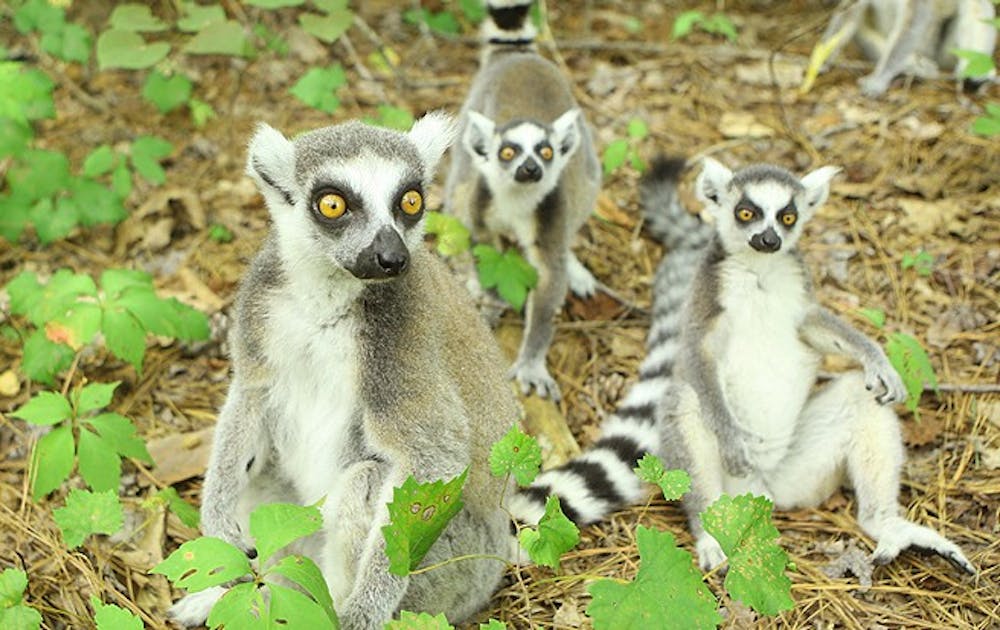Madagascar is home to the only wild lemurs on earth, but it might not be for long.
Due to increased hunting and deforestation in Madagascar, the world’s lemur population is more threatened than ever before. The Duke Lemur Center, which hosts the world’s highest number of lemurs outside of Madagascar, is increasing its efforts to protect lemur species and habitat because if conditions do not change, lemurs could be extinct by 2050, conservation coordinator Charles Welch said.
“We need to protect the forest for the lemurs to live in,” Welch said. “We do that in a lot of different ways, from environmental education to reforestation, conservation research and fish farming.”
At a meeting in July to update the status of lemurs on the International Union for Conservation of Nature Red-List, which compiles conservation statuses for endangered animals, the number of lemur species listed as critically endangered rose from eight to 23, endangered species increased from 18 to 52 and vulnerable species bumped up from 14 to 19. This update makes lemurs the most threatened mammals in the world, based on Red-List status.
Of the 19 lemur species at the Center, four are labeled critically endangered, six are endangered and three are considered vulnerable.
The DLC provides a sanctuary for lemurs in Durham, but also works in the field in northern Madagascar to protect lemurs. Welch himself has been working on lemur conservation for over 20 years, 15 of which he spent living in Madagascar.
Deforestation poses one of the gravest threats to lemurs in the wild. Due to expanding population and proliferation of slash and burn farming techniques, only about 10 percent of the country’s natural rainforests remain, Welch said.
Although deforestation is illegal inside national parks and reserves, the political situation in Madagascar makes it difficult to enforce these laws.
“The country is three years into a transition government that took transition by force and a lot of the aid has been pulled out of the country,” Welch said. “Any time there isn’t stability in the government, there isn’t really stability anywhere else.”
The loss of habitat also creates physical limitations for lemur species that are trying to breed.
“Part of the problem is now the forests are becoming so fragmented, you have these island populations of lemurs and you don’t have this flow between the fragments, and it’s really a dead end,” Welch said.
He added that forest fragmentation forces species to inbreed, which hurts their chances of survival. One focus of the DLC is the healthy breeding of lemur species, research manager Erin Ehmke said.
The hope is to keep lemur species’ genetic lineages healthy so that the lemurs can be reintroduced to Madagascar if the environmental situation there stabilizes.
The DLC and other conservancy groups have raised awareness about the lemurs’ plights, Welch said. The DLC also works to educate the people of Madagascar on the importance of protecting lemurs.
“An [increasing] problem in the past [has] been subsistence hunting—people who live on the edge of the forest who hunt and set traps for lemurs and eat them themselves,” Welch said. “Now there is more hunting on a larger scale than there was in the past and a lot of that is linked into the illegal traffic and cutting of wood.”
One of the DLC projects in Madagascar addresses the problem of lemur hunting through fish farming, to provide protein choices other than lemur meat.
The Center also works to inspire care for lemurs among the youth of Madagascar.
“It’s important that we do environmental education with kids, you can see how their minds open up and understand in different ways, but it takes time to get that impact up the road,” Welch said.
At the DLC, within miles of Duke’s campus, researchers work to alleviate the lemurs’ plight. The research is vital to helping the lemur population because the more scientists and activists know about the creatures, the better equipped they are to help them. The DLC scientists perform only noninvasive research, so that the lemurs are not harmed in the process.
Recent research conducted at the DLC indicates that lemurs are risk averse. When given the choice of doing one action for an assured two pieces of fruit or doing a second action, where they are unsure whether they will receive 10 or zero pieces of fruit, the lemurs will almost always choose the activity where they are assured of a reward.
Other research has demonstrated lemurs are highly cognitive mammals. In some experiments, they manipulate computer touchscreens to solve tasks. In fact, the lemurs get excited when they realize they are going to be given tests.
“When they see that computer cart rolling down the hall they get excited because they know they’re about to take on a task and do something challenging,” Ehmke said.
Get The Chronicle straight to your inbox
Signup for our weekly newsletter. Cancel at any time.

